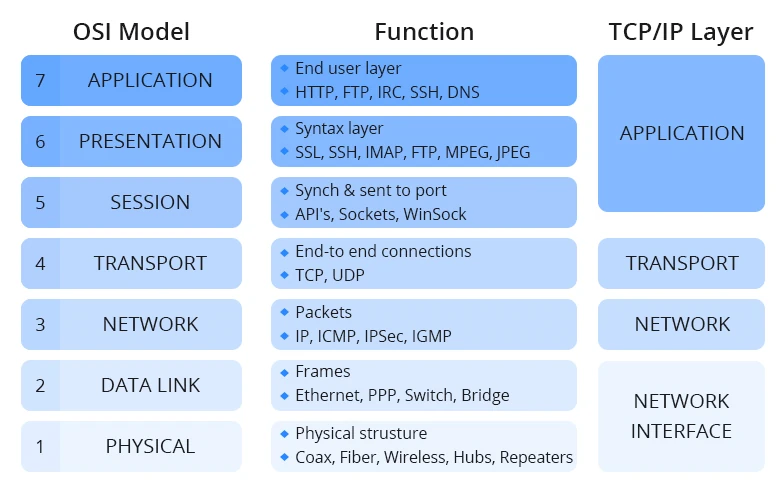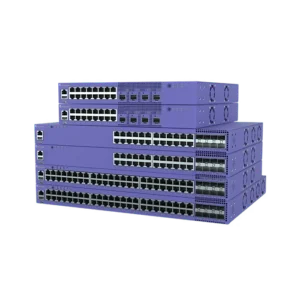There are managed switches, PoE switches, cloud-managed switches, industrial switches, but fewer people know exactly what the difference is between Layer 2 and Layer 3 switches. In this article, we compare these two types.
WHAT IS THE BLOG ABOUT?
- OSI MODEL & SWITCHING
- WHAT IS THE DIFFERENCE BETWEEN L2 AND L3?
- HOW TO CHOOSE THE RIGHT SWITCH
Let’s start at the beginning! Why is it important to know whether a switch is Layer 2 or 3?
A network switch can access all kinds of terminal devices, create local networks, LANs, and establish direct communication between all network devices. As the network evolves, different switches can be used within the network. According to the OSI model, a Layer 2 switch operates at the data link layer, while a Layer 3 switch operates at the network layer.
The fundamental question comes: Should I use a Layer 2 or Layer 3 switch? To make the right choice, we first need to understand the OSI model and the definition of network switches.
THE OSI MODEL AND THE NETWORK SWITCHES: WHAT ARE THEY?
The OSI Model
The Open Systems Interconnection (OSI) model is a conceptual framework that divides network communication functions into seven layers: physical, data link, network, transport, session, presentation, and application.
Sending data over a network is a complex process that requires the cooperation of different hardware and software technologies, crossing geographical boundaries and geographies. The OSI data model provides a universal language for computer networks, allowing different technologies to communicate using standard protocols or communication rules. Each technology must provide specific functionality within a specific layer and perform specific tasks to operate within the network. Higher-level technologies benefit from abstraction because they can use lower-level technologies without worrying about the underlying implementation details.

Advantages of the OSI model
► Hardware and software definition
► Process understanding and communication
► Effective troubleshooting
► Open interoperability
► Clear product function communication
Network switch
A network switch (also known as a switching hub, bridging hub, and, according to IEEE, a MAC bridge) is a network hardware device that connects devices on a computer network using packet switching to receive and forward data to a destination device.
A network switch is a multiport network bridge that uses MAC addresses to forward data at the data link layer (Layer 2) of the OSI model. Some switches can also forward data at the network layer (Layer 3) by incorporating routing functions. Such switches are commonly referred to as Layer 3 switches or multilayer switches.
What is a Layer 2 switch?
Operating in the network data link layer of the OSI model, a Layer 2 switch efficiently forwards data packets based on MAC addresses. It operates within the hardware layer, so no frame modification is required. Layer 2 switches are often used to connect workgroups and segment the network, increasing performance and reducing collision ranges.
The key features of a Layer 2 switch are as follows:
- High-speed forwarding: These switches achieve fast data frame forwarding by referring to the address table to find the port associated with the destination MAC address. This eliminates the need for decapsulation and encapsulation of data frames.
- Collision domain isolation: Each port of the Layer 2 switch is treated as an independent collision domain, reducing collisions and frame retransmissions, thereby improving network performance.
- VLAN support: Layer 2 switches allow the creation and management of virtual LANs (VLANs). By adding VLAN IDs to data frames, different logical networks can be divided and controlled effectively.
What is a Layer 3 switch?
Layer 2 and Layer 3 switches differ primarily in their routing capabilities. A Layer 2 switch operates solely on MAC addresses, ignoring IP addresses and higher-layer elements. A Layer 3 switch performs the functions of a Layer 2 switch and adds static and dynamic routing capabilities. This means that a Layer 3 switch maintains both MAC address and IP routing tables, facilitating intra-VLAN communication and forwarding packets across different VLANs. In addition, there are Layer 2+ (Layer 3 Lite) switches that offer only static routing. Layer 3 switches not only route packets, but also provide advanced features such as VLAN traffic tagging based on IP addresses, but also have the ability to provide enhanced power, security, and network management capabilities.
The main functions of Layer 3 switches are as follows:
- Isolated data transmission domains: Each port of a Layer 3 switch acts as an independent data transmission domain, minimizing the impact of data transmission disturbances on network performance and strengthening network security.
- Routing protocol support: Layer 3 switches can accept various routing protocols (such as RIP, OSPF, BGP, etc.), enabling dynamic routing updates and exchanges with other routers or Layer 3 switches. This increases the reliability and resilience of the network.
- Policy routing support: Layer 3 switches provide policy routing capabilities based on source IP addresses, destination IP addresses, protocol types and other conditions. This allows for differential processing or forwarding of data packets based on their type or priority, optimizing network efficiency and quality.
What is the difference between Layer 2 and Layer 3 switches?
Below is a comparison of the main differences between Layer 2 and Layer 3 switches:
| Layer 2 Switch | Layer 3 Switch | |
| Routing | Routing function only works with MAC address | Supports higher level routing such as static and dynamic routing |
| Transfer method | Sends frames to the destination based on the MAC address | Routes the packet using the IP address |
| Transmission speed | Quite fast as it does not look at Layer 3 of data packets | It takes time to inspect data packets before sending them to their destination. |
| Communication range | Can only communicate within a network | Able to communicate within and outside the network |
| Data transmission range | It has a single data sending range | It has multiple data sending ranges |
| Costs | Cost-effective | More expensive |
HOW TO CHOOSE THE RIGHT SWITCH FOR YOUR NETWORK NEEDS?
When choosing between a Layer 2 and Layer 3 switch, consider the following:
Layer2 switch:
- Network size: Suitable for small to medium-sized networks that require high-speed connectivity within the same network segment.
- Network segmentation: Helps reduce congestion and improve performance by dividing the network into smaller domains in a LAN setup.
- Cost-effectiveness: Usually less expensive due to limited functionality.
- Simple subnet networks: Suitable for low-traffic single subnet networks.
Layer 3 switch:
- Advanced routing: Required for networks that require inter-VLAN routing, QoS, and security features.
- Multiple VLANs: Allows inter-VLAN routing, making it ideal for organizations with large, complex network setups.
- Network Scalability: Provides greater scalability by handling routing across multiple segments, preventing congestion and enabling complex traffic patterns.
- Future Expansion: Recommended for networks that are expected to grow and provide advanced routing capabilities.
IMPORTANT NOTE
In network systems, Layer 2 and Layer 3 switches can be combined according to different needs and scenarios to increase the efficiency and reliability of network communication.
If you want to know more about network switches before purchasing, please get in contact with us!
The 4000 Series are ExtremeCloud IQ-managed Layer 2 switches that simplify network operations while providing the performance and flexibility of traditional enterprise access switches.
The 5320 series is a family of high-performance, feature-rich edge switches designed for next-generation digital businesses. Available in 16, 24 and 48-port Gigabit models, the 5320 is a stackable, universal hardware switching platform.





